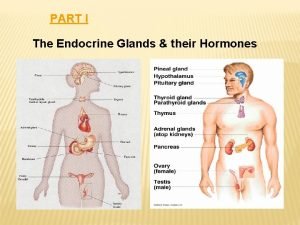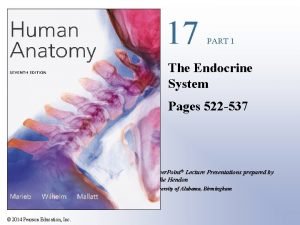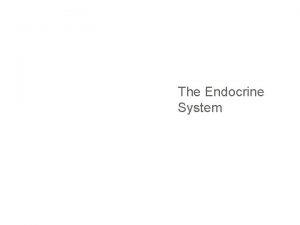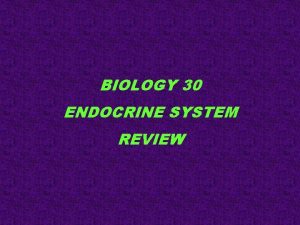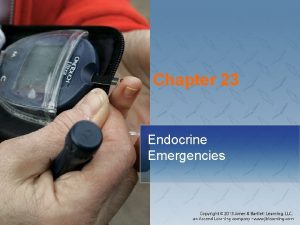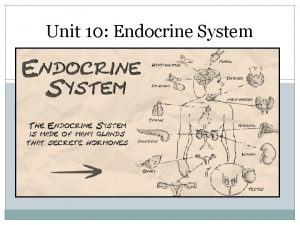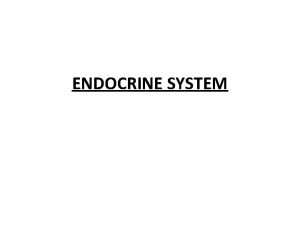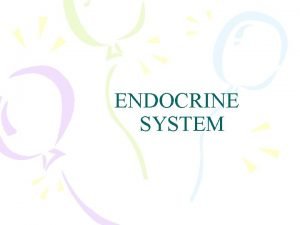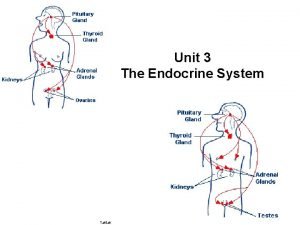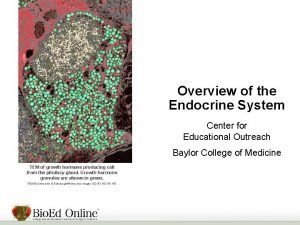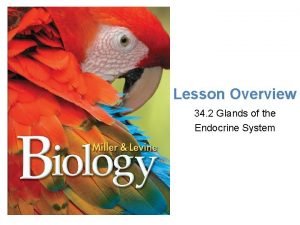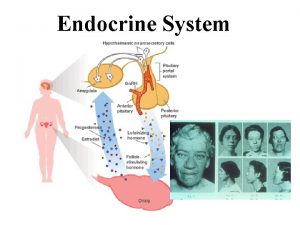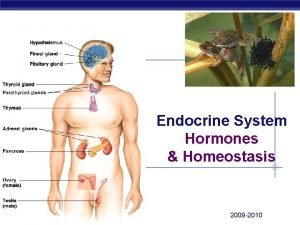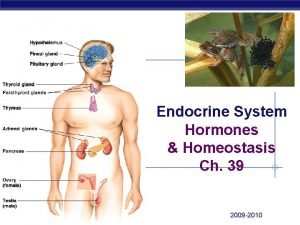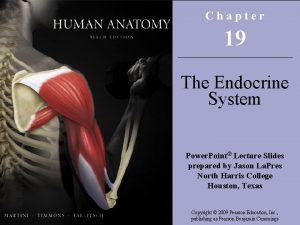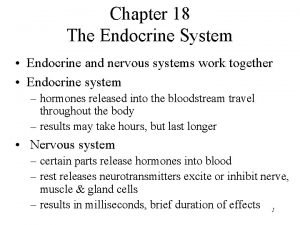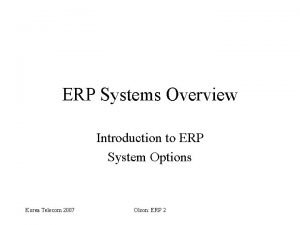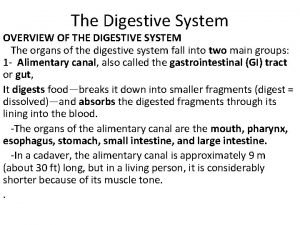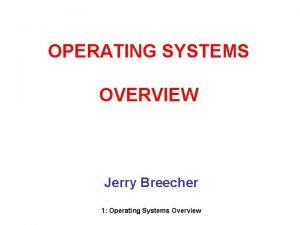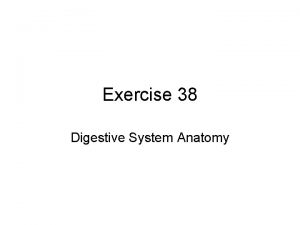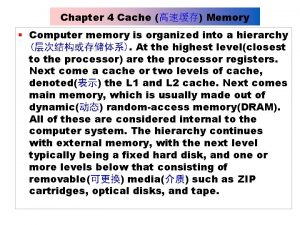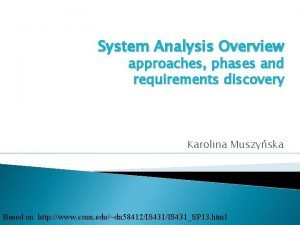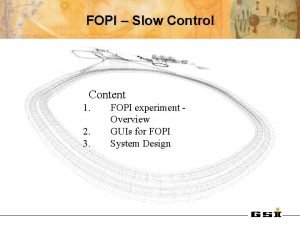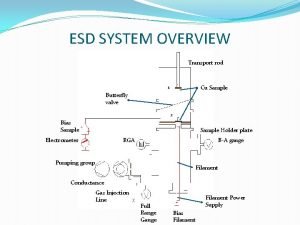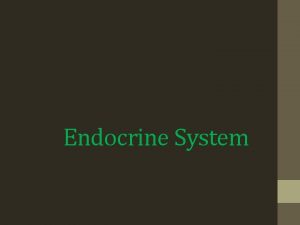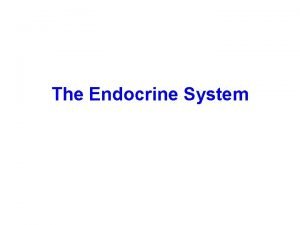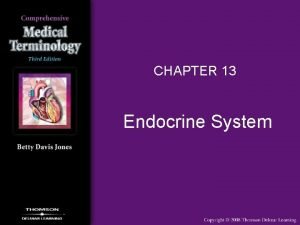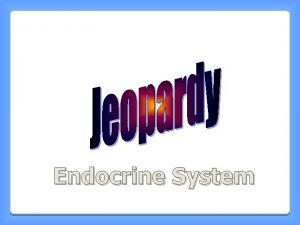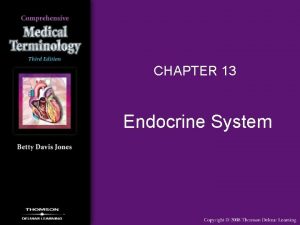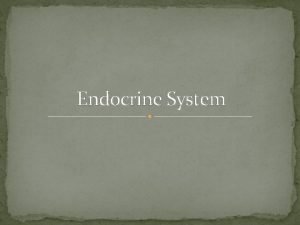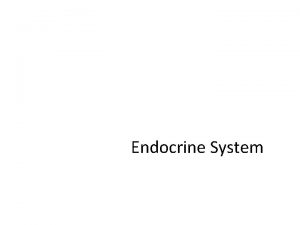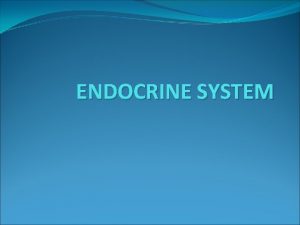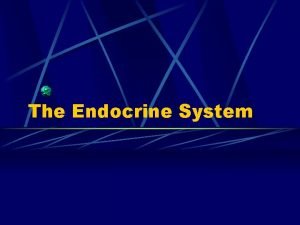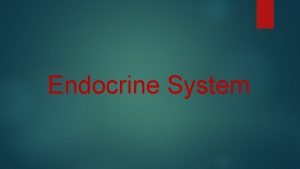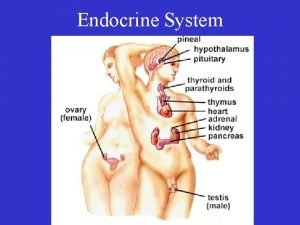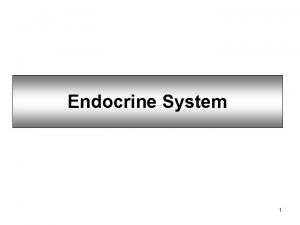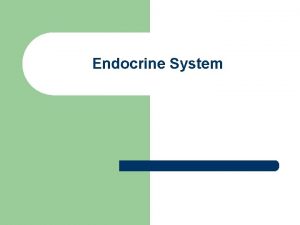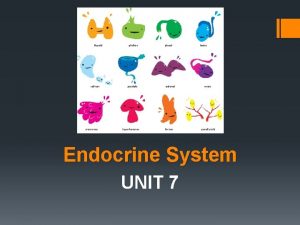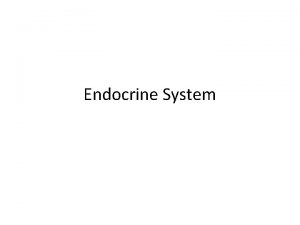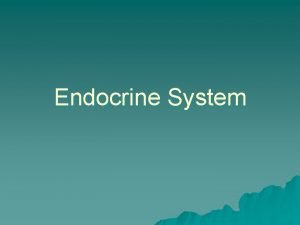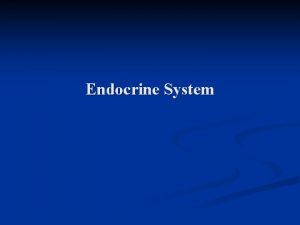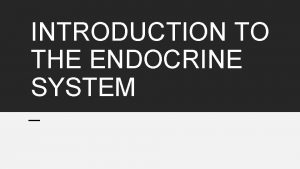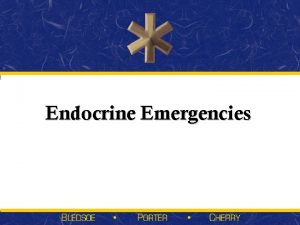The Endocrine System 16 Endocrine System Overview Endocrine






























































































- Slides: 94

The Endocrine System 16

Endocrine System: Overview ▪ Endocrine system – the body’s second great controlling system which influences metabolic activities of cells by means of hormones ▪ Endocrine glands – pituitary, thyroid, parathyroid, adrenal, pineal, and thymus ▪ The pancreas and gonads produce both hormones and exocrine products Chapter 16: 2

Endocrine System: Overview ▪ The hypothalamus has both neural functions and releases hormones ▪ Other tissues and organs that produce hormones – adipose cells, pockets of cells in the walls of the small intestine, stomach, kidneys, and heart Chapter 16: 3

Major Endocrine Organs Chapter 16: 4 Figure 16. 1

Autocrines and Paracrines ▪ Autocrines – chemicals that exert their effects on the same cells that secrete them ▪ Paracrines – locally acting chemicals that affect cells other than those that secrete them ▪ These are not considered hormones since hormones are long-distance chemical signals Chapter 16: 5

Hormones ▪ Hormones – chemical substances secreted by cells into the extracellular fluids ▪ Regulate the metabolic function of other cells ▪ Have lag times ranging from seconds to hours ▪ Tend to have prolonged effects ▪ Are classified as amino acid-based hormones, or steroids ▪ Eicosanoids – biologically active lipids with local hormone–like activity Chapter 16: 6

Types of Hormones ▪ Amino acid based – most hormones belong to this class, including: ▪ Amines, thyroxine, peptide, and protein hormones ▪ Steroids – gonadal and adrenocortical hormones ▪ Eicosanoids – leukotrienes and prostaglandins Chapter 16: 7

Hormone Action ▪ Hormones alter target cell activity by one of two mechanisms ▪ Second messengers involving: ▪ Regulatory G proteins ▪ Amino acid–based hormones ▪ Direct gene activation involving steroid hormones ▪ The precise response depends on the type of the target cell Chapter 16: 8

Mechanism of Hormone Action ▪ Hormones produce one or more of the following cellular changes in target cells ▪ Alter plasma membrane permeability ▪ Stimulate protein synthesis ▪ Activate or deactivate enzyme systems ▪ Induce secretory activity ▪ Stimulate mitosis Chapter 16: 9

Amino Acid-Based Hormone Action: c. AMP Second Messenger ▪ Hormone (first messenger) binds to its receptor, which then binds to a G protein ▪ The G protein is then activated as it binds GTP, displacing GDP ▪ Activated G protein activates the effector enzyme adenylate cyclase ▪ Adenylate cyclase generates c. AMP (second messenger) from ATP ▪ c. AMP activates protein kinases, which then cause cellular effects Chapter 16: 10

Amino Acid-Based Hormone Action: c. AMP Second Messenger Chapter 16: 11 Figure 16. 2 a

Amino Acid-Based Hormone Action: PIP-Calcium ▪ Hormone binds to the receptor and activates G protein ▪ G protein binds and activates a phospholipase enzyme ▪ Phospholipase splits the phospholipid PIP 2 into diacylglycerol (DAG) and IP 3 (both act as second messengers) ▪ DAG activates protein kinases; IP 3 triggers release of Ca 2+ stores ▪ Ca 2+ (third messenger) alters cellular responses Chapter 16: 12

Amino Acid-Based Hormone Action: PIP-Calcium Chapter 16: 13 Figure 16. 2 b

Steroid Hormones ▪ Steroid hormones and thyroid hormone diffuse easily into their target cells ▪ Once inside, they bind activate a specific intracellular receptor ▪ The hormone-receptor complex travels to the nucleus and binds a DNA-associated receptor protein ▪ This interaction prompts DNA transcription to produce m. RNA ▪ The m. RNA is translated into proteins, which bring about a cellular effect Chapter 16: 14

Steroid Hormones Chapter 16: 15 Figure 16. . 3

Target Cell Specificity ▪ Hormones circulate to all tissues but only activate cells referred to as target cells ▪ Target cells must have specific receptors to which the hormone binds ▪ These receptors may be intracellular or located on the plasma membrane Chapter 16: 16

Target Cell Specificity ▪ Examples of hormone activity ▪ ACTH receptors are only found on certain cells of the adrenal cortex ▪ Thyroxin receptors are found on nearly all cells of the body Chapter 16: 17

Target Cell Activation ▪ Target cell activation depends on three factors ▪ Blood levels of the hormone ▪ Relative number of receptors on the target cell ▪ The affinity of those receptors for the hormone ▪ Up-regulation – target cells form more receptors in response to the hormone ▪ Down-regulation – target cells lose receptors in response to the hormone Chapter 16: 18

Hormone Concentrations in the Blood ▪ Hormones circulate in the blood in two forms – free or bound ▪ Steroids and thyroid hormone are attached to plasma proteins ▪ All others are unencumbered Chapter 16: 19

Hormone Concentrations in the Blood ▪ Concentrations of circulating hormone reflect: ▪ Rate of release ▪ Speed of inactivation and removal from the body ▪ Hormones are removed from the blood by: ▪ Degrading enzymes ▪ The kidneys ▪ Liver enzyme systems Chapter 16: 20

Interaction of Hormones at Target Cells ▪ Three types of hormone interaction ▪ Permissiveness – one hormone cannot exert its effects without another hormone being present ▪ Synergism – more than one hormone produces the same effects on a target cell ▪ Antagonism – one or more hormones opposes the action of another hormone Chapter 16: 21

Control of Hormone Release ▪ Blood levels of hormones: ▪ Are controlled by negative feedback systems ▪ Vary only within a narrow desirable range ▪ Hormones are synthesized and released in response to: ▪ Humoral stimuli ▪ Neural stimuli ▪ Hormonal stimuli Chapter 16: 22

Humoral Stimuli ▪ Humoral stimuli – secretion of hormones in direct response to changing blood levels of ions and nutrients ▪ Example: concentration of calcium ions in the blood ▪ Declining blood Ca 2+ concentration stimulates the parathyroid glands to secrete PTH (parathyroid hormone) ▪ PTH causes Ca 2+ concentrations to rise and the stimulus is removed Chapter 16: 23

Humoral Stimuli Chapter 16: 24 Figure 16. 4 a

Neural Stimuli ▪ Neural stimuli – nerve fibers stimulate hormone release ▪ Preganglionic sympathetic nervous system (SNS) fibers stimulate the adrenal medulla to secrete catecholamines Chapter 16: 25 Figure 16. 4 b

Hormonal Stimuli ▪ Hormonal stimuli – release of hormones in response to hormones produced by other endocrine organs ▪ The hypothalamic hormones stimulate the anterior pituitary ▪ In turn, pituitary hormones stimulate targets to secrete still more hormones Chapter 16: 26

Hormonal Stimuli Chapter 16: 27 Figure 16. 4 c

Nervous System Modulation ▪ The nervous system modifies the stimulation of endocrine glands and their negative feedback mechanisms ▪ The nervous system can override normal endocrine controls ▪ For example, control of blood glucose levels ▪ Normally the endocrine system maintains blood glucose ▪ Under stress, the body needs more glucose ▪ The hypothalamus and the sympathetic nervous system are activated to supply ample glucose Chapter 16: 28

Major Endocrine Organs: Pituitary (Hypophysis) ▪ Pituitary gland – two-lobed organ that secretes nine major hormones ▪ Neurohypophysis – posterior lobe (neural tissue) and the infundibulum ▪ Receives, stores, and releases hormones from the hypothalamus ▪ Adenohypophysis – anterior lobe, made up of glandular tissue ▪ Synthesizes and secretes a number of hormones Chapter 16: 29

Major Endocrine Organs: Pituitary (Hypophysis) Chapter 16: 30 Figure 16. 5

Pituitary-Hypothalamic Relationships: Posterior Lobe ▪ The posterior lobe is a downgrowth of hypothalamic neural tissue ▪ Has a neural connection with the hypothalamus (hypothalamic-hypophyseal tract) ▪ Nuclei of the hypothalamus synthesize oxytocin and antidiuretic hormone (ADH) ▪ These hormones are transported to the posterior pituitary Chapter 16: 31

Pituitary-Hypothalamic Relationships: Anterior Lobe ▪ The anterior lobe of the pituitary is an outpocketing of the oral mucosa ▪ There is no direct neural contact with the hypothalamus Chapter 16: 32

Pituitary-Hypothalamic Relationships: Anterior Lobe ▪ There is a vascular connection, the hypophyseal portal system, consisting of: ▪ The primary capillary plexus ▪ The hypophyseal portal veins ▪ The secondary capillary plexus Chapter 16: 33

Pituitary-Hypothalamic Relationships: Anterior Lobe Chapter 16: 34 Figure 16. 5

Adenohypophyseal Hormones ▪ The six hormones of the adenohypophysis: ▪ Are abbreviated as GH, TSH, ACTH, FSH, LH, and PRL ▪ Regulate the activity of other endocrine glands ▪ In addition, pro-opiomelanocortin (POMC): ▪ Has been isolated from the pituitary ▪ Is enzymatically split into ACTH, opiates, and MSH Chapter 16: 35

Activity of the Adenohypophysis ▪ The hypothalamus sends a chemical stimulus to the anterior pituitary ▪ Releasing hormones stimulate the synthesis and release of hormones ▪ Inhibiting hormones shut off the synthesis and release of hormones Chapter 16: 36

Activity of the Adenohypophysis ▪ The tropic hormones that are released are: ▪ Thyroid-stimulating hormone (TSH) ▪ Adrenocorticotropic hormone (ACTH) ▪ Follicle-stimulating hormone (FSH) ▪ Luteinizing hormone (LH) Chapter 16: 37

Growth Hormone (GH) ▪ Produced by somatotropic cells of the anterior lobe that: ▪ Stimulate most cells, but target bone and skeletal muscle ▪ Promote protein synthesis and encourage the use of fats for fuel ▪ Most effects are mediated indirectly by somatomedins Chapter 16: 38

Growth Hormone (GH) ▪ Antagonistic hypothalamic hormones regulate GH ▪ Growth hormone–releasing hormone (GHRH) stimulates GH release ▪ Growth hormone–inhibiting hormone (GHIH) inhibits GH release Chapter 16: 39

Metabolic Action of Growth Hormone ▪ GH stimulates liver, skeletal muscle, bone, and cartilage to produce insulin-like growth factors ▪ Direct action promotes lipolysis and inhibits glucose uptake Chapter 16: 40

Metabolic Action of Growth Hormone Chapter 16: 41 Figure 16. 6

Thyroid Stimulating Hormone (Thyrotropin) ▪ Tropic hormone that stimulates the normal development and secretory activity of the thyroid gland ▪ Triggered by hypothalamic peptide thyrotropinreleasing hormone (TRH) ▪ Rising blood levels of thyroid hormones act on the pituitary and hypothalamus to block the release of TSH Chapter 16: 42

Adrenocorticotropic Hormone (Corticotropin) ▪ Stimulates the adrenal cortex to release corticosteroids ▪ Triggered by hypothalamic corticotropin-releasing hormone (CRH) in a daily rhythm ▪ Internal and external factors such as fever, hypoglycemia, and stressors can trigger the release of CRH Chapter 16: 43

Gonadotropins ▪ Gonadotropins – follicle-stimulating hormone (FSH) and luteinizing hormone (LH) ▪ Regulate the function of the ovaries and testes ▪ FSH stimulates gamete (egg or sperm) production ▪ Absent from the blood in prepubertal boys and girls ▪ Triggered by the hypothalamic gonadotropinreleasing hormone (Gn. RH) during and after puberty Chapter 16: 44

Functions of Gonadotropins ▪ In females ▪ LH works with FSH to cause maturation of the ovarian follicle ▪ LH works alone to trigger ovulation (expulsion of the egg from the follicle) ▪ LH promotes synthesis and release of estrogens and progesterone Chapter 16: 45

Functions of Gonadotropins ▪ In males ▪ LH stimulates interstitial cells of the testes to produce testosterone ▪ LH is also referred to as interstitial cell-stimulating hormone (ICSH) Chapter 16: 46

Prolactin (PRL) ▪ In females, stimulates milk production by the breasts ▪ Triggered by the hypothalamic prolactin-releasing hormone (PRH) ▪ Inhibited by prolactin-inhibiting hormone (PIH) ▪ Blood levels rise toward the end of pregnancy ▪ Suckling stimulates PRH release and encourages continued milk production Chapter 16: 47

The Posterior Pituitary and Hypothalamic Hormones ▪ Posterior pituitary – made of axons of hypothalamic neurons, stores antidiuretic hormone (ADH) and oxytocin ▪ ADH and oxytocin are synthesized in the hypothalamus ▪ ADH influences water balance ▪ Oxytocin stimulates smooth muscle contraction in breasts and uterus ▪ Both use PIP-calcium second-messenger mechanism Chapter 16: 48

Oxytocin ▪ Oxytocin is a strong stimulant of uterine contraction ▪ Regulated by a positive feedback mechanism to oxytocin in the blood ▪ This leads to increased intensity of uterine contractions, ending in birth ▪ Oxytocin triggers milk ejection (“letdown” reflex) in women producing milk Chapter 16: 49

Oxytocin ▪ Synthetic and natural oxytocic drugs are used to induce or hasten labor ▪ Plays a role in sexual arousal and satisfaction in males and nonlactating females Chapter 16: 50

Antidiuretic Hormone (ADH) ▪ ADH helps to avoid dehydration or water overload ▪ Prevents urine formation ▪ Osmoreceptors monitor the solute concentration of the blood ▪ With high solutes, ADH is synthesized and released, thus preserving water ▪ With low solutes, ADH is not released, thus causing water loss from the body ▪ Alcohol inhibits ADH release and causes copious urine output Chapter 16: 51

Thyroid Gland ▪ The largest endocrine gland, located in the anterior neck, consists of two lateral lobes connected by a median tissue mass called the isthmus ▪ Composed of follicles that produce the glycoprotein thyroglobulin ▪ Colloid (thyroglobulin + iodine) fills the lumen of the follicles and is the precursor of thyroid hormone ▪ Other endocrine cells, the parafollicular cells, produce the hormone calcitonin Chapter 16: 52

Thyroid Gland Chapter 16: 53 Figure 16. 7

Thyroid Hormone ▪ Thyroid hormone – the body’s major metabolic hormone ▪ Consists of two closely related iodine-containing compounds ▪ T 4 – thyroxine; has two tyrosine molecules plus four bound iodine atoms ▪ T 3 – triiodothyronine; has two tyrosines with three bound iodine atoms Chapter 16: 54

Effects of Thyroid Hormone ▪ TH is concerned with: ▪ Glucose oxidation ▪ Increasing metabolic rate ▪ Heat production ▪ TH plays a role in: ▪ Maintaining blood pressure ▪ Regulating tissue growth ▪ Developing skeletal and nervous systems ▪ Maturation and reproductive capabilities Chapter 16: 55

Synthesis of Thyroid Hormone ▪ Thyroglobulin is synthesized and discharged into the lumen ▪ Iodides (I–) are actively taken into the cell, oxidized to iodine (I 2), and released into the lumen ▪ Iodine attaches to tyrosine, mediated by peroxidase enzymes, forming T 1 (monoiodotyrosine, or MIT), and T 2 (diiodotyrosine, or DIT) ▪ Iodinated tyrosines link together to form T 3 and T 4 ▪ Colloid is then endocytosed and combined with a lysosome, where T 3 and T 4 are cleaved and diffuse into the bloodstream Chapter 16: 56

Synthesis of Thyroid Hormone Chapter 16: 57 Figure 16. 8

Transport and Regulation of TH ▪ T 4 and T 3 bind to thyroxine-binding globulins (TBGs) produced by the liver ▪ Both bind to target receptors, but T 3 is ten times more active than T 4 ▪ Peripheral tissues convert T 4 to T 3 ▪ Mechanisms of activity are similar to steroids ▪ Regulation is by negative feedback ▪ Hypothalamic thyrotropin-releasing hormone (TRH) can overcome the negative feedback Chapter 16: 58

Calcitonin ▪ A peptide hormone produced by the parafollicular, or C, cells ▪ Lowers blood calcium levels in children ▪ Antagonist to parathyroid hormone (PTH) Chapter 16: 59

Calcitonin ▪ Calcitonin targets the skeleton, where it: ▪ Inhibits osteoclast activity (and thus bone resorption) and release of calcium from the bone matrix ▪ Stimulates calcium uptake and incorporation into the bone matrix ▪ Regulated by a humoral (calcium ion concentration in the blood) negative feedback mechanism Chapter 16: 60

Parathyroid Glands ▪ Tiny glands embedded in the posterior aspect of the thyroid ▪ Cells are arranged in cords containing oxyphil and chief cells ▪ Chief (principal) cells secrete PTH ▪ PTH (parathormone) regulates calcium balance in the blood Chapter 16: 61

Parathyroid Glands Chapter 16: 62 Figure 16. 10 a

Effects of Parathyroid Hormone ▪ PTH release increases Ca 2+ in the blood as it: ▪ Stimulates osteoclasts to digest bone matrix ▪ Enhances the reabsorption of Ca 2+ and the secretion of phosphate by the kidneys ▪ Increases absorption of Ca 2+ by intestinal mucosal cells ▪ Rising Ca 2+ in the blood inhibits PTH release Chapter 16: 63

Effects of Parathyroid Hormone Chapter 16: 64 Figure 16. 11

Adrenal (Suprarenal) Glands ▪ Adrenal glands – paired, pyramid-shaped organs atop the kidneys ▪ Structurally and functionally, they are two glands in one ▪ Adrenal medulla – nervous tissue that acts as part of the SNS ▪ Adrenal cortex – glandular tissue derived from embryonic mesoderm Chapter 16: 65

Adrenal Cortex ▪ Synthesizes and releases steroid hormones called corticosteroids ▪ Different corticosteroids are produced in each of the three layers ▪ Zona glomerulosa – mineralocorticoids (chiefly aldosterone) ▪ Zona fasciculata – glucocorticoids (chiefly cortisol) ▪ Zona reticularis – gonadocorticoids (chiefly androgens) Chapter 16: 66

Adrenal Cortex Chapter 16: 67 Figure 16. 12 a

Mineralocorticoids ▪ Regulate the electrolyte concentrations of extracellular fluids ▪ Aldosterone – most important mineralocorticoid ▪ Maintains Na+ balance by reducing excretion of sodium from the body ▪ Stimulates reabsorption of Na+ by the kidneys Chapter 16: 68

Mineralocorticoids ▪ Aldosterone secretion is stimulated by: ▪ Rising blood levels of K+ ▪ Low blood Na+ ▪ Decreasing blood volume or pressure Chapter 16: 69

The Four Mechanisms of Aldosterone Secretion ▪ Renin-angiotensin mechanism – kidneys release renin, which is converted into angiotensin II that in turn stimulates aldosterone release ▪ Plasma concentration of sodium and potassium – directly influences the zona glomerulosa cells ▪ ACTH – causes small increases of aldosterone during stress ▪ Atrial natriuretic peptide (ANP) – inhibits activity of the zona glomerulosa Chapter 16: 70

The Four Mechanisms of Aldosterone Secretion Chapter 16: 71 Figure 16. 13

Glucocorticoids (Cortisol) ▪ Help the body resist stress by: ▪ Keeping blood sugar levels relatively constant ▪ Maintaining blood volume and preventing water shift into tissue ▪ Cortisol provokes: ▪ Gluconeogenesis (formation of glucose from noncarbohydrates) ▪ Rises in blood glucose, fatty acids, and amino acids Chapter 16: 72

Excessive Levels of Glucocorticoids ▪ Excessive levels of glucocorticoids: ▪ Depress cartilage and bone formation ▪ Inhibit inflammation ▪ Depress the immune system ▪ Promote changes in cardiovascular, neural, and gastrointestinal function Chapter 16: 73

Gonadocorticoids (Sex Hormones) ▪ Most gonadocorticoids secreted are androgens (male sex hormones), and the most important one is testosterone ▪ Androgens contribute to: ▪ The onset of puberty ▪ The appearance of secondary sex characteristics ▪ Sex drive in females ▪ Androgens can be converted into estrogens after menopause Chapter 16: 74

Adrenal Medulla ▪ Made up of chromaffin cells that secrete epinephrine and norepinephrine ▪ Secretion of these hormones causes: ▪ Blood glucose levels to rise ▪ Blood vessels to constrict ▪ The heart to beat faster ▪ Blood to be diverted to the brain, heart, and skeletal muscle Chapter 16: 75

Adrenal Medulla ▪ Epinephrine is the more potent stimulator of the heart and metabolic activities ▪ Norepinephrine is more influential on peripheral vasoconstriction and blood pressure Chapter 16: 76

Stress and the Adrenal Gland Chapter 16: 77 Figure 16. 15

Pancreas ▪ A triangular gland, which has both exocrine and endocrine cells, located behind the stomach ▪ Acinar cells produce an enzyme-rich juice used for digestion (exocrine product) ▪ Pancreatic islets (islets of Langerhans) produce hormones (endocrine products) ▪ The islets contain two major cell types: ▪ Alpha (α) cells that produce glucagon ▪ Beta (β) cells that produce insulin Chapter 16: 78

Glucagon ▪ A 29 -amino-acid polypeptide hormone that is a potent hyperglycemic agent ▪ Its major target is the liver, where it promotes: ▪ Glycogenolysis – the breakdown of glycogen to glucose ▪ Gluconeogenesis – synthesis of glucose from lactic acid and noncarbohydrates ▪ Release of glucose to the blood from liver cells Chapter 16: 79

Insulin ▪ A 51 -amino-acid protein consisting of two amino acid chains linked by disulfide bonds ▪ Synthesized as part of proinsulin and then excised by enzymes, releasing functional insulin ▪ Insulin: ▪ Lowers blood glucose levels ▪ Enhances transport of glucose into body cells ▪ Counters metabolic activity that would enhance blood glucose levels Chapter 16: 80

Effects of Insulin Binding ▪ The insulin receptor is a tyrosine kinase enzyme ▪ After glucose enters a cell, insulin binding triggers enzymatic activity that: ▪ Catalyzes the oxidation of glucose for ATP production ▪ Polymerizes glucose to form glycogen ▪ Converts glucose to fat (particularly in adipose tissue) Chapter 16: 81

Regulation of Blood Glucose Levels ▪ The hyperglycemic effects of glucagon and the hypoglycemic effects of insulin Chapter 16: 82 Figure 16. 17

Diabetes Mellitus (DM) ▪ Results from hyposecretion or hypoactivity of insulin ▪ The three cardinal signs of DM are: ▪ Polyuria – huge urine output ▪ Polydipsia – excessive thirst ▪ Polyphagia – excessive hunger and food consumption ▪ Hyperinsulinism – excessive insulin secretion, resulting in hypoglycemia Chapter 16: 83

Diabetes Mellitus (DM) Chapter 16: 84 Figure 16. 18

Gonads: Female ▪ Paired ovaries in the abdominopelvic cavity produce estrogens and progesterone ▪ They are responsible for: ▪ Maturation of the reproductive organs ▪ Appearance of secondary sexual characteristics ▪ Breast development and cyclic changes in the uterine mucosa Chapter 16: 85

Gonads: Male ▪ Testes located in an extra-abdominal sac (scrotum) produce testosterone ▪ Testosterone: ▪ Initiates maturation of male reproductive organs ▪ Causes appearance of secondary sexual characteristics and sex drive ▪ Is necessary for sperm production ▪ Maintains sex organs in their functional state Chapter 16: 86

Pineal Gland ▪ Small gland hanging from the roof of the third ventricle of the brain ▪ Secretory product is melatonin ▪ Melatonin is involved with: ▪ Day/night cycles ▪ Physiological processes that show rhythmic variations (body temperature, sleep, appetite) Chapter 16: 87

Thymus ▪ Lobulated gland located deep to the sternum in the thorax ▪ Major hormonal products are thymopoietins and thymosins ▪ These hormones are essential for the development of the T lymphocytes (T cells) of the immune system Chapter 16: 88

Other Hormone-Producing Structures ▪ Heart – produces atrial natriuretic peptide (ANP), which reduces blood pressure, blood volume, and blood sodium concentration ▪ Gastrointestinal tract – enteroendocrine cells release local-acting digestive hormones ▪ Placenta – releases hormones that influence the course of pregnancy Chapter 16: 89

Other Hormone-Producing Structures ▪ Kidneys – secrete erythropoietin, which signals the production of red blood cells ▪ Skin – produces cholecalciferol, the precursor of vitamin D ▪ Adipose tissue – releases leptin, which is involved in the sensation of satiety, and stimulates increased energy expenditure Chapter 16: 90

Developmental Aspects ▪ Hormone-producing glands arise from all three germ layers ▪ Endocrine glands derived from mesoderm produce steroid hormones ▪ Endocrine organs operate smoothly throughout life ▪ Most endocrine glands show structural changes with age, but hormone production may or may not be affected Chapter 16: 91

Developmental Aspects ▪ Exposure to pesticides, industrial chemicals, arsenic, dioxin, and soil and water pollutants disrupts hormone function ▪ Sex hormones, thyroid hormone, and glucocorticoids are vulnerable to the effects of pollutants ▪ Interference with glucocorticoids may help explain high cancer rates in certain areas Chapter 16: 92

Developmental Aspects ▪ Ovaries undergo significant changes with age and become unresponsive to gonadotropins ▪ Female hormone production declines, the ability to bear children ends, and problems associated with estrogen deficiency (e. g. , osteoporosis) begin to occur ▪ Testosterone also diminishes with age, but effect is not usually seen until very old age Chapter 16: 93

Developmental Aspects ▪ GH levels decline with age and this accounts for muscle atrophy with age ▪ Supplemental GH may spur muscle growth, reduce body fat, and help physique ▪ TH declines with age, causing lower basal metabolic rates ▪ PTH levels remain fairly constant with age, and lack of estrogen in women makes them more vulnerable to bone-demineralizing effects of PTH Chapter 16: 94
 Endocrine system and reproductive system
Endocrine system and reproductive system Endocrine system vs nervous system
Endocrine system vs nervous system Lympathic
Lympathic Endo crine gland
Endo crine gland Endocrine system
Endocrine system Hát kết hợp bộ gõ cơ thể
Hát kết hợp bộ gõ cơ thể Slidetodoc
Slidetodoc Bổ thể
Bổ thể Tỉ lệ cơ thể trẻ em
Tỉ lệ cơ thể trẻ em Voi kéo gỗ như thế nào
Voi kéo gỗ như thế nào Thang điểm glasgow
Thang điểm glasgow Chúa yêu trần thế alleluia
Chúa yêu trần thế alleluia Các môn thể thao bắt đầu bằng tiếng bóng
Các môn thể thao bắt đầu bằng tiếng bóng Thế nào là hệ số cao nhất
Thế nào là hệ số cao nhất Các châu lục và đại dương trên thế giới
Các châu lục và đại dương trên thế giới Công thức tính độ biến thiên đông lượng
Công thức tính độ biến thiên đông lượng Trời xanh đây là của chúng ta thể thơ
Trời xanh đây là của chúng ta thể thơ Mật thư anh em như thể tay chân
Mật thư anh em như thể tay chân 101012 bằng
101012 bằng độ dài liên kết
độ dài liên kết Các châu lục và đại dương trên thế giới
Các châu lục và đại dương trên thế giới Thơ thất ngôn tứ tuyệt đường luật
Thơ thất ngôn tứ tuyệt đường luật Quá trình desamine hóa có thể tạo ra
Quá trình desamine hóa có thể tạo ra Một số thể thơ truyền thống
Một số thể thơ truyền thống Cái miệng xinh xinh thế chỉ nói điều hay thôi
Cái miệng xinh xinh thế chỉ nói điều hay thôi Vẽ hình chiếu vuông góc của vật thể sau
Vẽ hình chiếu vuông góc của vật thể sau Biện pháp chống mỏi cơ
Biện pháp chống mỏi cơ đặc điểm cơ thể của người tối cổ
đặc điểm cơ thể của người tối cổ Thế nào là giọng cùng tên? *
Thế nào là giọng cùng tên? * Vẽ hình chiếu đứng bằng cạnh của vật thể
Vẽ hình chiếu đứng bằng cạnh của vật thể Fecboak
Fecboak Thẻ vin
Thẻ vin đại từ thay thế
đại từ thay thế điện thế nghỉ
điện thế nghỉ Tư thế ngồi viết
Tư thế ngồi viết Diễn thế sinh thái là
Diễn thế sinh thái là Các loại đột biến cấu trúc nhiễm sắc thể
Các loại đột biến cấu trúc nhiễm sắc thể Số nguyên là gì
Số nguyên là gì Tư thế ngồi viết
Tư thế ngồi viết Lời thề hippocrates
Lời thề hippocrates Thiếu nhi thế giới liên hoan
Thiếu nhi thế giới liên hoan ưu thế lai là gì
ưu thế lai là gì Sự nuôi và dạy con của hươu
Sự nuôi và dạy con của hươu Khi nào hổ con có thể sống độc lập
Khi nào hổ con có thể sống độc lập Sơ đồ cơ thể người
Sơ đồ cơ thể người Từ ngữ thể hiện lòng nhân hậu
Từ ngữ thể hiện lòng nhân hậu Thế nào là mạng điện lắp đặt kiểu nổi
Thế nào là mạng điện lắp đặt kiểu nổi Chapter 16
Chapter 16 Adenohypophysis
Adenohypophysis Differences between nervous system and endocrine
Differences between nervous system and endocrine Comparison of endocrine and nervous system
Comparison of endocrine and nervous system Gonads glands
Gonads glands Endocrine system fact
Endocrine system fact Rhinarium
Rhinarium Chapter 45 hormones and the endocrine system
Chapter 45 hormones and the endocrine system Endocrine system pearson
Endocrine system pearson Are endocrine glands ductless
Are endocrine glands ductless Chapter 7 13 endocrine system
Chapter 7 13 endocrine system Mammillary body
Mammillary body Figure of endocrine system
Figure of endocrine system Chapter 11 endocrine system
Chapter 11 endocrine system Biology 30 endocrine system
Biology 30 endocrine system Sella turcica
Sella turcica Chapter 23 the endocrine system
Chapter 23 the endocrine system Endocrine system analogy
Endocrine system analogy Introduction of endocrine system
Introduction of endocrine system Endocrine system abbreviations
Endocrine system abbreviations Endocrine system
Endocrine system Endocrine system
Endocrine system Endocrine system
Endocrine system Baylor
Baylor Endocrine glands
Endocrine glands Endocrine system
Endocrine system Chapter 16 lesson 2 the male reproductive system
Chapter 16 lesson 2 the male reproductive system Endocrine system regents questions
Endocrine system regents questions Endocrine system regents questions
Endocrine system regents questions Nontropic hormones
Nontropic hormones Endocrine tissues
Endocrine tissues What are the lipid soluble hormones
What are the lipid soluble hormones Erp 2 systems
Erp 2 systems Features of a good content management system
Features of a good content management system Conclusion for computerized accounting
Conclusion for computerized accounting Overview of the digestive system
Overview of the digestive system Sap project systems overview
Sap project systems overview Operating system overview
Operating system overview Use case diagram for fitness center
Use case diagram for fitness center Exercise 38 anatomy of the digestive system
Exercise 38 anatomy of the digestive system Computer memory system overview
Computer memory system overview Computer memory system overview
Computer memory system overview British school system overview
British school system overview Chapter 2 an overview of the financial system
Chapter 2 an overview of the financial system British school system overview
British school system overview System design
System design System design overview
System design overview System overview sample
System overview sample
















































